Dr. Beverly Daniel Tatum visited the University Tuesday night for the 2020 Martin Luther King Jr. lecture, discussing at length what it means to be a person of color in America, both historically and today.
Tatum, the former president of Spelman College — a historically Black college for women in Atlanta, Georgia — spoke in the Salomon Center with Vice President for Institutional Equity and Diversity Shontay Delalue. Tatum also authored the acclaimed 1997 book “Why Are All the Black Kids Sitting Together in the Cafeteria?: And Other Conversations About Race.”
In her discussion, Tatum touched on issues ranging from what it means to be a Black student in a predominantly white school — which she covered in her 1987 book “Assimilation Blues” — to who claims different identities.
The night began with a callback to Martin Luther King Jr.’s 1967 book, “Where Do We Go From Here: Chaos Or Community?”, as Delalue contrasted its discussion of education with what Tatum wrote in “Why Are All the Black Kids Sitting Together in the Cafeteria?”
“They’re describing the same thing, which is systemic inequity within the state of our education,” Tatum said at the lecture. “Many people are surprised to learn our schools are almost as segregated today as they were back then. What we can say for sure is that hyper-segregated schools that have very few white students are predictably under-resourced.”
Tatum said that the existence of hyper-segregation makes engaging students who are different from one another even more important for the world of higher education.
“College represents an opportunity to be in a diverse learning environment, more diverse than the one (students) grew up in,” Tatum said in an interview with The Herald.
Tatum also told The Herald that court cases threatening to end race-conscious admissions could hinder engagement of students on diverse campuses, pointing to the effects that occurred within the University of California system when the state ended the practice.
“What we saw in California was a dramatic drop in the number of Black, Latinx and Native American students who were admitted. I think you would probably see a similar drop if there was no similar consideration of race (at other universities), which would be unfortunate,” Tatum said, noting that the commonly proposed alternative of paying attention to socioeconomic diversity alone could not “guarantee racial diversity.”
“Some of what people are needing to learn,” Tatum said at the lecture, “is how to engage with people whose life experience isn’t the same as your own.”
Tatum’s first teaching job in academia was closely tied to this type of engagement: On stage, she described teaching “Group Exploration of Racism” at UC Santa Barbara.
“At the end of the semester, my students wrote on course evaluations things like: ‘This course has changed my life. Why is it that I had to wait until I was a senior in college to have these discussions?’ It really became clear to me that there was a need for something like this in the curriculum.”
During the lecture, Tatum also discussed questions of identity in a country becoming increasingly diverse.
“Young adults are asking questions about ‘who am I?’” Tatum said. “I sometimes ask people to fill in the sentence, ‘I am … fill in the blank.’”
The identities in which people “feel marginalized,” Tatum said, are often the ones that get put down.
“How we think about who we are is not just in our own heads. It has to do with our interactions with other people and the feedback that we are getting,” she said. “If you write down ‘I’m pretty,’ it’s likely that it’s because someone gave you that feedback from childhood on.”
Tatum ended the night on a note of hope, prompted by a question from a high school student regarding whether or not institutional racism and discrimination would ever end.
“Looking at the Brown motto, 'In God we hope,' it made me think about a quote from (lawyer and author of “Just Mercy”) Bryan Stevenson,” Tatum said. “He says it’s necessary to be hopeful: Injustice persists when hopelessness prevails. Because you have to feel hopeful to work against injustice.”
Celia Browning, a first-year student at St. John’s University in Queens, New York, said that the diverse makeup of the crowd helped her believe Tatum’s closing remarks.
“I’m so happy this crowd included so many different people,” Browning said. “Being here, it’s easy to maintain hope that conversations will happen and more inclusivity will happen in the future of our country.”
Domingo Lora, a junior at the University of Rhode Island, said he thought Tatum’s lecture was “insightful” regarding the current education system in America and “the interconnection between our current forms and old forms of segregation.” He also noted that people, especially white people, have to take responsibility regarding “modern segregation.”

Will Kubzansky was the 133rd editor-in-chief and president of the Brown Daily Herald. Previously, he served as a University News editor overseeing the admission & financial aid and staff & student labor beats. In his free time, he plays the guitar and soccer — both poorly.





